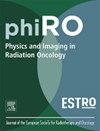一种新型的多模态拟人化幻影增强了放射治疗中磁共振成像质量保证指南的依从性
IF 3.4
Q2 ONCOLOGY
引用次数: 0
摘要
背景和目的磁共振成像(MRI)在放射治疗(RT)模拟中的应用越来越多,促使医学物理与工程研究所(IPEM)和美国医学物理学家协会(AAPM)制定了质量保证(QA)指南。本研究将一种新型的多模态拟人体与美国放射学院(ACR)的拟人体进行比较,以进行rt中MRI特异性QA测试的一部分。材料和方法将一种新型的3d打印多模态头颈部拟人体与ACR大型MRI拟人体进行比较。进行IPEM和aapm推荐的QA测试,包括信息学/连通性/数据传输、MRI-CT配准、端到端QA和使用RT附件的信噪比(SNR)/百分比积分均匀性(PIU)评估。结果两种模型均适用于信息学/连接/数据传输。MRI-CT配准未发现错误;ACR幻像提供了更多的定量地标,而拟人化幻像提供了有限的结构。两种模型的目标配准误差(TREs)均低于0.97 mm,骰子相似系数(DSC)均高于0.9,符合要求。对于端到端QA,拟人模体促进了1.994 Gy的剂量测量,而计算的剂量为2.01 Gy(−0.8%)。信噪比和PIU评估显示,放射学设置与RT设置相比,两种幻影的值更高。结论与ACR模型不同,与剂量测量设备兼容的多模态拟人模型可以实现真实的端到端质量保证。虽然ACR幻影适用于信息学和MRI-CT注册,但拟人化幻影更能代表临床场景。对于全面的QA, ACR和拟人化幻影都是必需的。此外,大视场(FOV)幻象对于评估大视场MRI畸变至关重要。本文章由计算机程序翻译,如有差异,请以英文原文为准。
A novel multimodality anthropomorphic phantom enhances compliance with quality assurance guidelines for magnetic resonance imaging in radiotherapy
Background and purpose
The use of magnetic resonance imaging (MRI) for radiotherapy (RT) simulation has grown, prompting quality assurance (QA) guidelines by the Institute of Physics and Engineering in Medicine (IPEM) and the American Association of Physicists in Medicine (AAPM). This study compares a novel multimodality anthropomorphic phantom to an American College of Radiology (ACR) phantom for a subset of these MRI-specific QA tests in RT.
Materials and methods
A novel 3D-printed multimodality head-and-neck anthropomorphic phantom was compared to an ACR large MRI phantom. IPEM and AAPM-recommended QA tests were conducted, including informatics/connectivity/data transfer, MRI-CT registration, end-to-end QA, and signal-to-noise ratio (SNR)/percentage integral uniformity (PIU) assessments using RT accessories.
Results
Both phantoms were suitable for informatics/connectivity/data transfer. In MRI-CT registration, no errors were found; the ACR phantom offered more quantitative landmarks, while the anthropomorphic phantom provided limited structures. Both phantoms achieved target registration errors (TREs) below 0.97 mm and dice similarity coefficient (DSC) values above 0.9, meeting guidelines. For end-to-end QA, the anthropomorphic phantom facilitated dose measurements of 1.994 Gy versus a calculated 2.01 Gy (−0.8 %). SNR and PIU assessments showed higher values in radiology setups compared to RT setups for both phantoms.
Conclusions
Multimodality anthropomorphic phantoms compatible with dosimetric equipment allow realistic end-to-end QA, unlike the ACR phantom. While the ACR phantom is suitable for informatics and MRI-CT registration, anthropomorphic phantoms better represent clinical scenarios. For comprehensive QA, both ACR and anthropomorphic phantoms are required. Additionally, large field-of-view (FOV) phantoms are crucial for evaluating large FOV MRI distortions.
求助全文
通过发布文献求助,成功后即可免费获取论文全文。
去求助
来源期刊

Physics and Imaging in Radiation Oncology
Physics and Astronomy-Radiation
CiteScore
5.30
自引率
18.90%
发文量
93
审稿时长
6 weeks
 求助内容:
求助内容: 应助结果提醒方式:
应助结果提醒方式:


